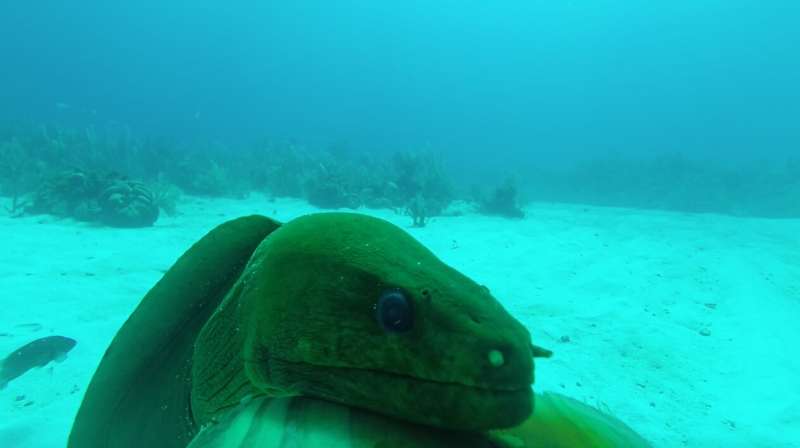Moray eels thrive on coral reefs close to people—overfishing of other predators, like sharks, may be the cause

Coral reefs that are in close proximity to larger populations of people tend to have fewer sharks and other fish due to higher fishing pressure. But new research shows there's one group of predators that's the exception—moray eels.
Scientists from FIU's Institute of Environment used a combination of video data from Global FinPrint—the world's first and largest shark and ray survey—and environmental DNA analysis to conduct the largest study in the Caribbean on moray eel populations.
Reefs located closer to humans usually have higher levels of fishing, which depletes sharks and other large predatory fish. Morays, though, don't taste very good to people and have little commercial value. Not being a good catch works to their advantage.
"Global FinPrint was set up to study sharks but an added benefit was that moray eels also went after the bait. They were often very aggressive, sometimes biting at stingrays, reef fish and even small sharks," said Demian Chapman, Global FinPrint co-lead and FIU associate professor.
Moray eels are mysterious and notoriously difficult to study. They are usually lurking in even the smallest crevices of coral reefs, stalking their prey—fish, octopuses, crabs and lobsters—and launching a sneak attack from below. This is where the Global FinPrint data became helpful and provided a never-before-seen look at just how common these hidden predators are on certain reefs.
Baited underwater cameras were used to survey 67 reefs in 12 Caribbean nations. On reefs further from humans where sharks and other large predatory fish are still common, morays were less common or stayed hidden for the most part. On reefs closer to people, where sharks and other large predators are fished, the morays were more common and weren't afraid to creep out and start snapping at anything in the way of a meal.
In addition to the video data, this study also relied on environmental DNA—or eDNA—analysis to trace whether morays were around, even if they were hiding and didn't make an appearance on camera.
Water samples were taken from several of the Global FinPrint sites. DNA was then extracted from feces or sloughed off skin particles in the water to determine what eel species were around. Analysis followed the patterns documented in the video data. On the reefs closer to people, there were more morays present.
The scientists can't yet draw a definite cause-and-effect connection between fewer sharks leading to more morays. However, they emphasize the need for more research. After all, when the balance of the reef is disrupted, growing populations of morays could have unknown consequences for the entire ecosystem.
"We know sharks prey upon moray eels and likely compete with them for prey, but now we have to ask how important are these interactions in driving moray eel populations and behavior on coral reefs," said Gina Clementi, a marine ecologist and co-lead author of the study in FIU's Predator Ecology and Conservation Lab. "There is more work to be done in answering these questions about morays, and I'm excited to see future research dig deeper into the ecology of these cryptic reef predators."
Global FinPrint received core funding support from the Paul G. Allen Family Foundation and was led by FIU scientists Chapman and Dean of the College of Arts, Sciences & Education Mike Heithaus. The work was conducted by hundreds of scientists, researchers, and conservationists organized by a network of collaborators. Earlier this summer, the Global FinPrint team published their first set of findings, revealing sharks are functionally extinct along 20 percent of the reefs surveyed.
The moray study was recently published in iScience.
More information: Gina M. Clementi et al. Moray eels are more common on coral reefs subject to higher human pressure in the greater Caribbean, iScience (2021). DOI: 10.1016/j.isci.2021.102097
Journal information: iScience
Provided by Florida International University




















